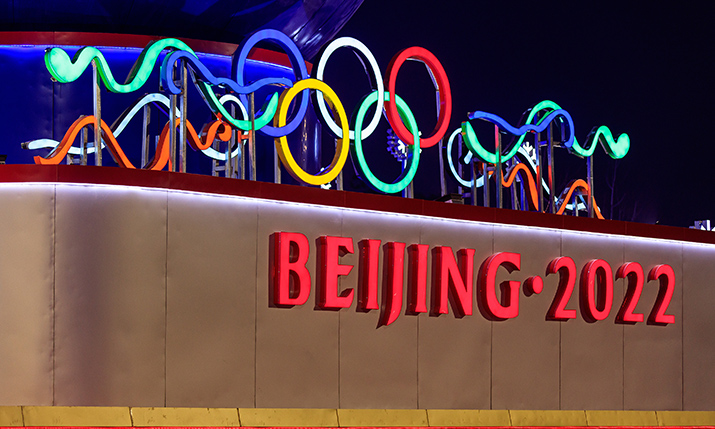Sustainable sports broadcasting: Vizrt explores lessons from the forthcoming Winter Olympics
 By Jonathan Roberts, SVP, global sport and virtual advertising, Vizrt
By Jonathan Roberts, SVP, global sport and virtual advertising, Vizrt
Without a doubt, one of the key engines powering the future of sports broadcasting is going to be sustainability. With several key technologies in the drive towards more sustainable productions already significantly boosted by the COVID-19 pandemic, the momentum now shifts towards cementing those gains. Remote production and the increasing implementation of cloud-based workflows have transformed the industry over the past two years; the aim now needs to lie in optimising them further and making sure that we don’t return to the extravagant carbon ways of the past.
The forthcoming Winter Olympics is drawing a line in the sand (or snow, for that matter,) regarding this. In some ways, it is ironic that an event so large and so global can be a leader in sustainable policies, but Olympic Broadcasting Services’ (OBS) work on the International Broadcasting Centre (IBC) for Beijing 2022 deserves recognition.
Range of innovations
The overall net broadcast footprint has been reduced from 36,000sqm to 30,000sqm by integrating the IBC and the Main Press Centre (MPC) together in a single venue (two were initially planned). This integration dramatically reduces the duplication of facilities.
A modular and prefabricated system will help reduce the fit-out timelines by up to 20%.
The same system, based on recyclable steel sheet panels, will be reused for the next three Games editions.
Centralised Technical Areas are being implemented to provide ‘data centre’ services, reducing heat, ventilation and air conditioning by concentrating power-hungry kits in central areas.
There’s more sustainable innovation spread out across the whole broadcast of the Games by OBS too, all designed to minimise the impact on the environment. Furthermore, individual broadcasters are undertaking their own efforts. Driven in part by the necessities of COVID-secure production, the size of teams being sent out to such large-scale events has fallen dramatically.
The landscape has shifted in everyday sports broadcasting — few realistically expect commentary teams to actually be at the event they’re covering anymore — and this is being replicated in the Olympics-scale productions too. Broadcasters across the world now accept fully redundant multiple feeds into their own local production galleries for vision mixing, graphics additions, commentary, replays and more.
Perhaps if COVID had hit a decade earlier we would all be scrabbling to go back to the way things were, but the crucial point is that the technology is there to make this new era of sustainable production happen.
Intercontinental low latency connections have also become further optimised over recent years, typically using undersea cable networks with satellite redundancy to provide roundtrips in the region of 200ms. Powered by the latest photorealistic advancements in 3D graphics engines, virtual sets are now indistinguishable from real ones, enabling broadcasters to keep their main presentation and talent back at home. Indeed, so ubiquitous have virtual sets become that viewers now find the more mundane physical sets slightly strange.
XR graphics
There is a clue here in that one of the new frontiers for capturing viewer eyeballs is likely to be extended reality (XR) graphics and using the ever-increasing amount of sports data and analysis being provided by a range of companies to drive engaging visual elements on a screen, further enhancing the understanding of the game and the fan experience. We are starting to see some truly innovative insight in sports as diverse as cricket and motor racing, and the way that these are being presented to the viewer is becoming both less intrusive and more informative at the same time.
Already, workflows are being developed where the data can travel alongside the video signals to a production hub, be round-tripped in a low latency environment with a third-party specialist XR graphics provider, before finally passing on to distribution via a range of platforms. Meanwhile, the commentators can be linked in from home studios to a remote gallery that is already producing its second event of the day with a third lined up for the evening shift.
The cloud is only going to make this easier over the coming period, allowing productions to add services at the click of a button without having to specifically engineer connectivity. This will allow broadcasters to genuinely choose best-in-class providers wherever they are in the (connected) world.
Crucially, this tech meets the sustainability targets that we believe are set to become more important to the industry as 2022 unfolds. Admittedly, the carbon footprint of cloud services can be opaque, but the providers are working on that information to enable productions to make informed choices. And, even in the present, there are obvious savings.
Broadcasters tend to leave production gallery equipment turned on 24/7 as the prospect of failure to boot, even in redundant systems, is something to be avoided. Cloud data centres are way more efficient than that, spinning up servers as and when needed. This alone dramatically reduces the power profile of an event.
We need to do more but we also need to do less. Viewers want increasingly next-generation experiences across a range of platforms, but we also need to minimise the impact of those services on the environment. Beijing 2022 is showing the way that this can be done, even when it comes to something as inflexible as a building. By moving production increasingly into the cloud, by steadily increasing the ratio of remote productions undertaken, by embracing sustainable concerns at all levels from Tier 1 downwards, we can all do our part to make sure that sports broadcasting is part of the solution and not a continuation of the problem.

